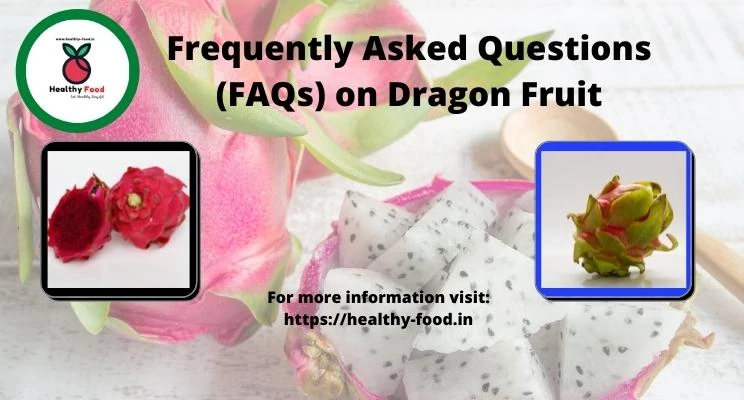Article Contents
Pitaya Dragon Fruit – FAQs (Frequently Asked Questions
1. Is Pitaya (Dragon Fruit) Juicy?

Dragon fruit or Pitaya is simple sweet tasty, and juicy fruit. You can use it to taste the drinks, and you can cook its leaves like vegetables. Its seeds have a nut-like flavor.
Perfect for refreshment and flavor, it is rich in water (juicy), loaded with many essential minerals, and integrated with nutrient ingredients perfect for healthy eating.
It is usually eaten raw, and you can use it for a variety of cool tasty juices.
2. Can a Diabetic Patient Eat Dragon Fruit?

Diabetic people can eat dragon fruit in a limited quantity to benefit from the other nutrients and high fiber present in the fruit.
It’s good for diabetes patients and is safe to eat. You should limit its intake as its GI (Glycemic Index) is in the middle range.
Glycemic Index of Dragon Fruit
Glycemic Index (GI) can be a number between 0 – 100 which indicates the rise of blood glucose levels after 2 hours of eating food.
Low GI foods are that food with a range less than or equal to 55. The high GI range is 70, and the middle range is between 56 and 69.
It measures carbohydrate content (total carbohydrates-fibe content) in food. The glycemic index of dragon fruit is similar to a banana’s 48-52.
Therefore it has a low Glycemic Index, and diabetic people can eat.
Know more about the Benefits of Dragon fruit in our article.
3. How Long Does Cut Dragon Fruit Last in the Fridge? Or How to Store Dragon Fruit?

You can keep the cut dragon fruit (Pitaya) in the fridge for up to three weeks, depending upon how you are storing it in the fridge. Or it can be frozen up for a year in a deep freezer wrapping in a plastic bag. Even it can also be dried and stored.
You can store the whole dragon fruit comfortably at room temperature. Some of these fruits may develop soft, slimy, and smooth surfaces when it is not in the fridge. You can cut the affected outer surface and use the inner flesh.
If it is ripe and you are not ready to enjoy it, keep it in a plastic bag in the refrigerator for up to 1 week. This storing technique can prevent the dragon fruit from picking up smells from other foods.
If it is not ripe, you can put it in a paper bag with an apple or a banana. The ethylene gas emitted from the apple or banana can accelerate the ripening process.
For cut pieces or once you have cut it up, the inner flesh is exposed to the air, and if you want to store these cut pieces, keep it in an airtight container for about 2 to 5 days, but throw it away when the flesh turns brown or mushy.
When you mix this fruit with other foods, such as fruit salad, it lasts just as long as other fruits in a fruit salad; I think the juices of other fruits in the salad protect the flesh from the air to some degree.
4. How to Cut a Dragon Fruit?

The Delicious flesh of dragon fruit (Pitaya) is a healthy tropical treat that you can serve as snacks, juice, smoothies, and other recipes.
To choose one, Dragon fruit should be a little softer when you check it with your finger. If it is too hard, you can still bring it home and leave it at your counter for 2-3 days to ripen.
Once you have cut and opened the this fruit, you will find flesh speckled with small black seeds. Depending on the species, the pulp may be white, red, or purple. Dragon fruit is considered a superfruit.
The peak season of the fruit is best in the summer months until early autumn. Once you have it open, you can enjoy the fruit as sliced and put it in salads, prepare smoothies, juices or put it on the grill.
Although the exterior looks hard, the skin is thin and smooth like mango. Below is a soft, fluffy, and waxy layer that can be easily separated from the pulp.
You can cut the this fruit in three easy steps:
Step 1: Cut in half
You can start it by placing the fruit on the cutting board. Use a sharp kitchen knife to cut the fruit in half. I recommend starting at the top and then going down into the main portion of the fruit. After cutting it into half, you can eat the flesh straight using a spoon.
Step 2: Remove the skin (2 Methods)
Method 1: Scoop it out
Now you have two halves; you have two options. Use a large spoon and scoop out the flesh.
Method 2: Peel the skin
Alternatively, you can peel off the thick skin using your fingers. It is easier to do this when you cut the fruit into fourths.
Step 3: Cut into smaller pieces (3 Methods or Ways)
Method 1: Slices
Depending on how you want to use the this fruit, accordingly, you can cut it into thick or thin slices. For an attractive fancy presentation, you can cut it into pieces with skin on like oranges.
Method 2: Cubes
Take the slices, cut them lengthwise, and turn and cut on the other side to create cubes. You can freeze ¾-inch cubes in a single layer to use in the dragon fruit smoothie.
Method 3: Spheres
To get the spherical shape cuttings, use a melon baller and scoop out the flesh while the skin is still intact for the round spheres.
5. How to Eat Dragon Fruit?

Dragon fruit (Pitaya) is best when you eat the fruit raw. You can even grill this Pitaya fruit like other fruits and also can enjoy it adding with other fruits:
1. Add frozen red dragon fruit to a smoothie
2. Add slices or cubes to the top of the mixed fruits acai bowl
3. Use a melon baller to create spheres and add to a fruit salad
4. Cut into thick pieces or large cubes on a square and grill
5. Place small pieces over oatmeal, night oats, or yogurt
6. You can toss it into a mango or pineapple salsa
7. Cocktail, Mocktail, Martini, Limeade, Margarita, Mojitos
8. Puddings, Cakes, Panna Cota
9. Deserts, Gelato
10. Fish, especially cod, tuna, and mahimahi
11. Salads
6. Can I Eat the Skin of Dragon Fruit?

One of the most common and frequently asked questions about dragon fruit (Pitaya) skin is whether one can eat it. There are two main arguments regarding the eating of dragon fruit’s skin.
First, some people claim that it is poisonous and should never be consumed. The other group is in favor of eating the skin. They argue that this fruit skin is nutritious and should be eaten by all means.
After all sorts of research and analysis, on the safe side, the dragon fruit skin is edible, can be eaten as there are numerous benefits you can get from eating the dragon skin from a nutritious point of view, you should eat dragon fruit skin. If you decide to do this, you should wash it thoroughly to remove pesticides.
The skin is not appreciated in terms of flavour and taste, but you can do some seasoning and add spices to make it tasty and attentive.
You may also want to cook the skin in a veggie sautee to make it soft and more edible. 60 – 70% of the total fruit is edible, but when you eat the skin also, then 90% of the fruit can be considered as edible.
7. What Are the Benefits of Dragon Fruit and its skin for health? Or Why to Eat Dragon Fruit Skin?

You should eat the dragon fruit skin as there are several reasons that you should start considering eating Pitaya or dragon fruit skin for the following five key benefits:
First, it contains substantial amount of fiber and protein while low in calories, fats, carbohydrates, and sugar.
Second, it is also rich in minerals, including vitamin A, vitamin C, calcium, iron, and magnesium.
Third, the skin of the this fruit is rich in anthocyanin and antioxidants. Findings from clinical research and testing have praised the benefits of anthocyanin. Anthocyanin plays a key role in reducing the risk associated with diabetes. There have been researched reports that anthocyanin has anti-cancer properties too.
Fourth, consumption of dragon fruit skin can also help weight loss and prevents lipid accumulation.
Fifth, dragon fruit skin is also a source of soluble fiber and food. The fiber in your diet facilitates bowel movements, maintains blood sugar levels, lowers cholesterol, and reduces the risk of death from heart disease.
8. Does Eating Yellow Pitaya (Dragon fruit) Cause a Watery Stool (Diarrhea)?

Eating Pitaya or dragon fruit regularly and in moderation has great benefits for our stomach and helps keep our digestive system healthy. This advantage of the dragon fruit is largely due to the presence of food fibers in them.
The dietary fiber found in this fruit acts as a natural laxative, which improves our bowel movement and ensures proper detoxification of our system. This provides relief from constipation and provides relief from other digestive problems such as abdominal pain, irritable bowel syndrome (IBS), flatulence and constipation, bloating, etc.
Although dietary fiber is important for our digestive health and provides many benefits, it is wise to eat the dragon’s fruit in moderation. This is because overeating or excessive dietary fiber intake can cause problems such as poor absorption of nutrients by intestines, intestinal gas, blockage, abdominal pain, and fluctuant, etc.
However, overeating dietary fiber without drinking enough water can increase the risk of dehydration which is known to cause various gut problems such as indigestion, increased risk of muscle cramps, watery stool or diarrhea, etc.
9. Can I Eat Dragon Fruit with Milk?

Yes, of course, you can enjoy this fruit with milk. You can prepare a dragon fruit milkshake.
This dragon fruit milkshake recipe is very simple; you can prepare it in four easy steps.
Step 1: Cut this fruit into half lengthwise, scoop out the flesh with a spoon.
Step 2: Put the scooped out dragon fruits, boiled, chilled milk, sugar, vanilla or rose essence, and ice cube in a blender.
Step 3: Blend the mixture for 3-4 minutes.
Step 4: Dragon fruit milkshake is ready. Pour it into serving glasses and enjoy!
10. Is Dragon Fruit Good for Dengue?

Pitaya or Dragon fruit is good for dengue as this fruit is considered an immunity booster. Dengue patients can be benefited from eating this fruit for the following benefits:
First, the high levels of vitamin C found in this fruit can stimulate the immune system while stimulating the activity of other antioxidants. The Vitamin C contained in this fruit can help boost the immune system and prevent dengue hemorrhagic fever. It is also good for light consumption, so someone suffering from fever can easily consume it.
Second, due to its high antioxidant properties, it helps to prevent the dangers of free radicals. Dragon fruit offers powerful antioxidants, phytonutrients, lycopene, high fiber, phosphorus, and iron content, so it makes sense to have it.
Third, the red dragon fruit is rich in protein and antioxidants (betacyanins), carotene, and lycopene. Dried red dragon fruit has ten times more nutrients than fresh fruit.
Fourth, Vitamins B1, B2, B3, as well as calcium, phosphorus, iron, protein, niacin, and fiber, also help improve your immune system function.
Fifth, dragon fruit helps increase the hemoglobin level in the body as it is loaded with iron. A lot of people do not pay attention to or notice low hemoglobin that can hamper immunity. Adding this fruit to the diet apart from green leafy foods can be more beneficial.
11. Can I Eat Dragon Fruit Every day?

Dragon fruit is safe to eat and offers many health benefits due to its vitamin C and antioxidant properties. The fruit is low in calories, making it an easy daily meal. However, some may be allergic to the fruit, with hives, swelling of the tongue, and vomiting. This type of allergic reaction is rare.
If you eat too much red dragon fruit, your urine may be red or pink. This side effect looks more disruptive than it is. The same thing happens when you eat a lot of beetroots. Your urine should return to its normal color once the fruit is completely out of your body.
Although the dragon’s fruit is beneficial to the body, it is still important to consider its effects when eaten daily.
There seem to be no side effects associated with eating dragon fruit every day, although it is still recommended that you check with your doctor first.
The following benefits of this fruit can convince you to add this food to your daily diet. But still, try to avoid too much consumption:
1. Dragon fruit has great benefits. It brings countless nutrients to the table – some of which you may not expect. Among other things, Pitaya is rich in magnesium, which can boost energy levels, relax muscles, reduce anxiety, improve sleep, and regulate sodium, potassium, and calcium levels.
2. This tropical fruit is packed with tons of antioxidants such as flavonoids, phenolic acid, and betacyanin to protect your cells from harmful free radicals.
3. Pitaya can reduce blood sugar, replacing damaged cells in charge of producing insulin. Dragon fruit’s high vitamin C content can fight chronic diseases. Plus, the high fiber contained in Pitaya can promote the fullness between meals, making it a perfect filler or snack. It also contains prebiotics which promotes a healthy gut by balancing out your intestinal bacteria.
4. Moreover, Dragon fruit contains 8% of your daily recommended iron intake. Helping break down food and transporting oxygen through your system, Pitaya’s iron is beneficial to prevent anemia.
12. Is Star Fruit the Same as Dragon Fruit?

No, star fruit is not the same as dragon fruit. Both fruits are different.
Star Fruit
Originally from Asia, the star fruit (Averrhoa carambola) is usually 5-18 cm long and looks like a five-point star when cut. The unripe fruit is translucent, firm, and green, while the ripe fruit is fragrant, yellow, and juicy. Their taste ranges from sour to sweet.
Star fruit is an excellent source of vitamin C that strengthens the immune system (about 57 percent of the daily value per serving), which is why you should get it in the cold and flu season.
Vitamin C also helps with collagen synthesis, a protein that keeps skin, hair, and nails healthy and strong. Also, it eliminates free radicals that cause disease and fights infections.
Dragon Fruit
Dragon fruit variety belongs to the family of cactus species or Cactaceae family or climbing cacti. It grows on the Hylocereus cactus.
Dragon fruit is also known as Pitaya and the Honolulu queen. Pitaya plants grow well in dry areas with enough sunlight.
The Pitaya plant is a long day plant, and its flowers only bloom at night. Because of this fact, this plant is also known as the moonflower or Lady of the night.
It has large white flowers that are 20cm long. These plants need organic soil to grow well.
The dragon fruit is a tropical fruit having an oval or elliptical appearance. This fruit was named after its appearance only — the name ‘dragon fruit’ is derived from Chinese mythology.
It’s unique in its appearance, where the spikes resemble fire and the scales resemble a dragon. The pointy “scales” around the oval-shaped fruit are reminiscent of a dragon.
Dragon fruit contains many antioxidants that are essential for good health and a healthy lifestyle. It also contains many vitamins and minerals. Let’s try to understand more about the taste of this unusual fruit in detail.
Originally this dragon fruit cactus grew and was found in Central America and Southern Mexico. But, It is now widespread and widely cultivated throughout the different regions of the world.
In Central America, this dragon fruit is known as Pitaya fruit. In the early 19th century, the French brought it to Southeast Asia, and from that time, these fruits were also grown in Thailand, Vietnam, and Australia.
These days it is even cultivated in India also. In Asia, people know this dragon fruit in the name of strawberry pear. Now, it is grown all over the planet. You can buy this dragon fruit throughout every part of the U.S.


Pingback: 12 Dragon Fruit Health Benefits & Nutrition - Healthy Food